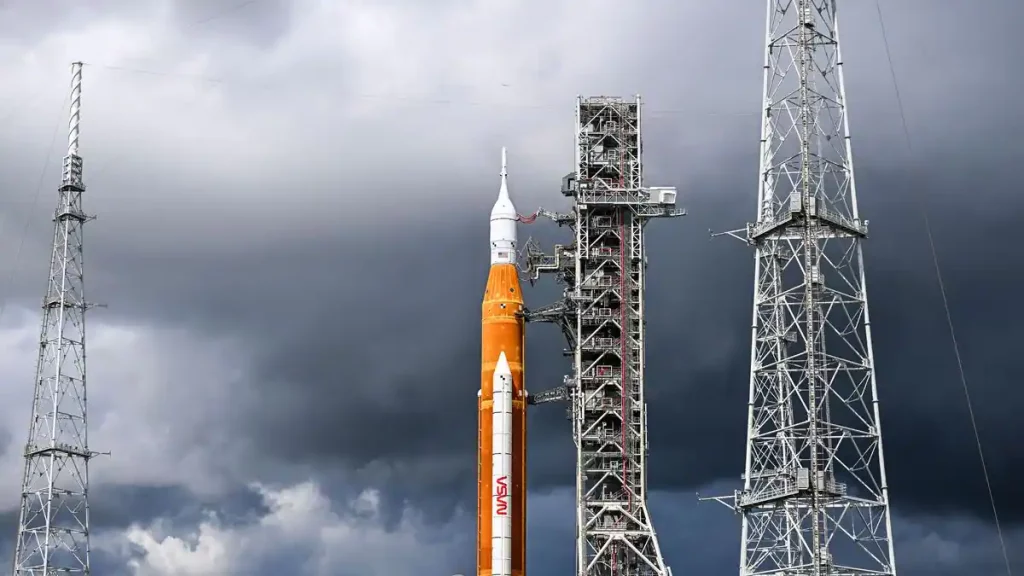The launch of NASA’s massive new rocket to the moon again was called off at the last minute on Saturday, for the second time in less than a week, delaying the launch of America’s pioneering lunar return program, Artemis.
Takeoff was originally scheduled for 2:17 pm local time (6:17 pm GMT), with a two-hour launch window. But after more than three hours of trying to solve the problem of fuel leaks during missile refueling operations, the launch teams were running out of time.
A NASA commentator said in a video broadcast that launch manager Charlie Blackwell Thompson made the final decision to cancel from the Kennedy Space Center in Florida.
A new attempt is likely on Monday or Tuesday, but NASA will have to analyze all parameters before deciding on a new date. After Tuesday, no new launch possibilities are possible before September 19 due to the location of the Earth and Moon.
Fifty years after the last Apollo mission, this first test mission, without a crew on board, is the first phase of the Artemis program, which aims to establish a permanent human presence on the Moon, then allow it to be used as a priority. starting point. towards Mars.
The orange and white SLS rocket, whose maiden flight was supposed to take place on Saturday, has been in development for more than a decade to become the most powerful in the world.
Shortly before 6 a.m. local time, the go-ahead was given to begin filling the rocket’s tanks with its cryogenic fuel – a total of about three million liters of super-cold liquid hydrogen and oxygen.
But at about 7:15 a.m., a leak was detected at the foot of the rocket, at the level of the tube through which hydrogen passes into the tank. The stream was halted as teams made three consecutive attempts to fix the problem, “to no avail,” NASA tweeted.
On Monday, during the first attempt, the launch was also canceled at the last moment due to technical problems, first a similar leak was overcome, and then the engines cooled.
In the middle of a long weekend in the US, as many as 400,000 people were expected to like take off, especially from the surrounding beaches.
The flight was also made by a group of astronauts, including Frenchman Thomas Pesquet.
Artemis 1 should allow verification that the Orion capsule, located on top of the rocket, is safe to transport future astronauts.
Thanks to this new ship, the US space agency intends to reconnect with distant human exploration, as the moon is 1,000 times farther from the International Space Station.
The trip is expected to take a total of six weeks. Orion will venture up to 64,000 kilometers behind the moon, farther than any other habitable spacecraft to date.
The main purpose of the Artemis 1 is to test the capsule’s heat shield, which is the largest of all. Returning to the Earth’s atmosphere, it will have to withstand a speed of 40,000 km / h and a temperature half the temperature of the surface of the Sun.
In total, the ship would have to travel about 2.1 million kilometers to land in the Pacific Ocean.
The mission’s full success will be a relief to NASA, which originally credited the first launch in 2017 of the SLS, and by the end of 2025 will have invested more than $90 billion in its new lunar program, according to a public audit.
The name Artemis was chosen after a female character, the twin sister of the Greek god Apollo – echoing the Apollo program, which sent only white men to the lunar surface between 1969 and 1972.
This time, NASA wants to allow the first person of color and the first woman to walk on the moon.
The next mission, Artemis 2, will take astronauts to the Moon in 2024, without landing there. This honor will be reserved for the crew of Artemis 3, in 2025 at the earliest. Then NASA wants to launch about one mission each year.
It would then be a matter of building a space station in lunar orbit, a portico, and a lunar base.
There, NASA wants to test the technologies needed to send the first humans to Mars: new suits, a navigation vehicle, a potential use of lunar water…
According to NASA Administrator Bill Nelson, a round trip to the Red Planet aboard Orion, which will last several years, could be attempted at the end of the 2000s.

“Total coffee aficionado. Travel buff. Music ninja. Bacon nerd. Beeraholic.”






More Stories
Fluoroscopy | “Self-coup”?
This is why you find it difficult to wake up in the morning.
She meets her boss at the airport after taking sick leave.